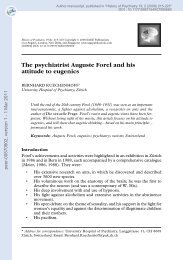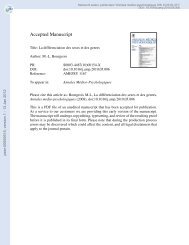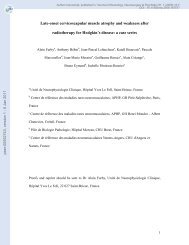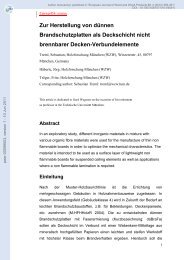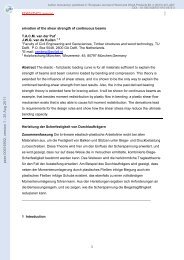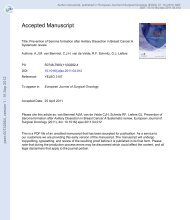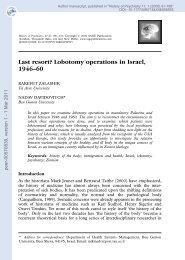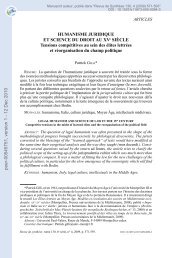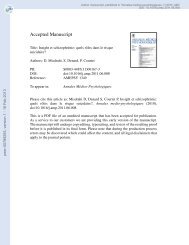Cosheaves and connectedness in formal topology
Cosheaves and connectedness in formal topology
Cosheaves and connectedness in formal topology
You also want an ePaper? Increase the reach of your titles
YUMPU automatically turns print PDFs into web optimized ePapers that Google loves.
peer-00821313, version 1 - 9 May 2013<br />
of a topos are models of a geometric theory, there is a natural def<strong>in</strong>ition of homomorphism.)<br />
These specialization morphisms are the 2-cells <strong>in</strong> a 2-category<br />
of toposes, <strong>and</strong> have horizontal <strong>and</strong> vertical composition <strong>in</strong> the usual way.<br />
We shall illustrate the idea with a discussion of a converse of Theorem 20,<br />
which said that if X is locally connected then its connected components cosheaf<br />
π 0 is a term<strong>in</strong>al cosheaf – i.e., a term<strong>in</strong>al po<strong>in</strong>t of MX. The converse is not<br />
actually true. In fact (see [22]), for every Grothendieck topos X there is a<br />
term<strong>in</strong>al cosheaf, whether or not X is locally connected. The correspond<strong>in</strong>g<br />
complete spread, a locally connected coreflection of X, is called the Gleason core<br />
of X (see [2, Section 6.2]), <strong>and</strong> it need not be homeomorphic to X. However,<br />
we can f<strong>in</strong>d a converse by re<strong>in</strong>terpret<strong>in</strong>g “po<strong>in</strong>t” <strong>in</strong> the generalized way – recall<br />
that a generalized po<strong>in</strong>t of X (at stage W ) is a map W → X. Let us say that<br />
a (global) po<strong>in</strong>t t : 1 → X is strongly term<strong>in</strong>al if for every generalized po<strong>in</strong>t<br />
x : W → X there is a unique homomorphism from x to t◦!. This is equivalent<br />
to t be<strong>in</strong>g right adjo<strong>in</strong>t to ! : X → 1, <strong>and</strong> X is called totally connected if it has<br />
such a po<strong>in</strong>t (see [23, C3.6.16]). The geometricity of Theorem 20 <strong>in</strong> fact shows<br />
that if X is locally connected then the connected components cosheaf π 0 is a<br />
strongly term<strong>in</strong>al cosheaf, so that MX is totally connected. We shall give a<br />
new proof of the converse.<br />
To motivate our presentation of results for local <strong>connectedness</strong> <strong>and</strong> MX, we<br />
shall first give an analogous presentation of known results regard<strong>in</strong>g overtness<br />
<strong>and</strong> the lower powerlocale. These do not <strong>in</strong>volve generalized spaces.<br />
7.1. The lower powerlocale<br />
A junior version of cosheaf is the lower powerpo<strong>in</strong>t (or [24] up-complete set of<br />
basics). Whereas a cosheaf is a colimit-preserv<strong>in</strong>g functor from sheaves to sets,<br />
a lower powerpo<strong>in</strong>t is a jo<strong>in</strong>-preserv<strong>in</strong>g function from opens to propositions. If<br />
X = (P, ≤, ⊳ 0 ) is a flat site, then a lower powerpo<strong>in</strong>t over it is a subset F ⊆ P ,<br />
up-closed with respect to ≤, such that if a ⊳ 0 U <strong>and</strong> a ∈ F then U meets<br />
F . This then gives a sublocale RestF of X [4] by add<strong>in</strong>g covers a ⊳ {a} ∩ F .<br />
The fundamental result of the lower powerlocale ([3]; see also [21], [4]) is that<br />
the assignment F ↦→ RestF gives a bijection between lower powerpo<strong>in</strong>ts <strong>and</strong><br />
overt, weakly closed sublocales (classically, these are the same as the closed<br />
sublocales). In the reverse direction, start<strong>in</strong>g from the sublocale Y , F can be<br />
recovered as the set of basic opens that are positive modulo Y .<br />
From the techniques of [6] (see also [10]) it can be deduced that the lower<br />
powerpo<strong>in</strong>ts are the po<strong>in</strong>ts of another flat site, for the lower powerlocale P L X<br />
of X. As a flat site it can be presented as (FP, ≤ U , ⊳ 0 ), FP be<strong>in</strong>g the (Kuratowski)<br />
f<strong>in</strong>ite powerset of P , where (i) S ≤ U T if for each t ∈ T there is some<br />
s ∈ S with s ≤ t, <strong>and</strong> (ii) for each basic cover a ⊳ 0 U <strong>in</strong> X, <strong>and</strong> for each<br />
S ∈ FP , we have a basic cover {a} ∪ S ⊳ 0 {{u} ∪ S | u ∈ U} <strong>in</strong> P L X. There<br />
is a map ↓: X → P L X, correspond<strong>in</strong>g to the fact that every po<strong>in</strong>t is already<br />
a lower powerpo<strong>in</strong>t. Each lower powerpo<strong>in</strong>t F has a map 1 → P L X, <strong>and</strong> the<br />
24



